"You'll never listen to the world the same way again. A truly ear-opening experience!" —Chris Ferrie, award-winning physicist and author of Where Did the Universe Come From? And Other Cosmic Questions
For readers of Neil deGrasse Tyson and Bill O'Neill, What the Ear Hears (and Doesn't) is a fascinating science book for adults that explores the physics principle of frequency and the (sometimes weird) role it plays in our everyday lives.
What do the world's loneliest whale, a black hole, and twenty-three people doing Tae Bo all have in common?
In 2011, a skyscraper in South Korea began to shake uncontrollably without warning and was immediately evacuated. Was it an earthquake? An attack? No one seemed quite sure. The actual cause emerged later and is utterly fascinating: Twenty-three middle-aged folks were having a Tae Bo fitness class in the office gym on the twelfth floor. Their beats had inadvertently matched the building's natural frequency, and this coincidence—harnessing a basic principle of physics—caused the building to shake at an alarming rate for ten minutes. Frequency is all around us, but little understood.
Musician, composer, TV presenter, and educator Richard Mainwaring uses the concept of the Infinite Piano to reveal the extraordinary world of frequency in a multitude of arenas—from medicine to religion to the environment to the paranormal—through the universality of music and a range of memorable human (and animal) stories laced with dry humor. Whether you're science curious, musically inclined, or just want to know what a Szechuan pepper has to do with physics, What the Ear Hears (and Doesn't) is an immensely enjoyable read filled with "did you know?" trivia you'll love to share with friends.


